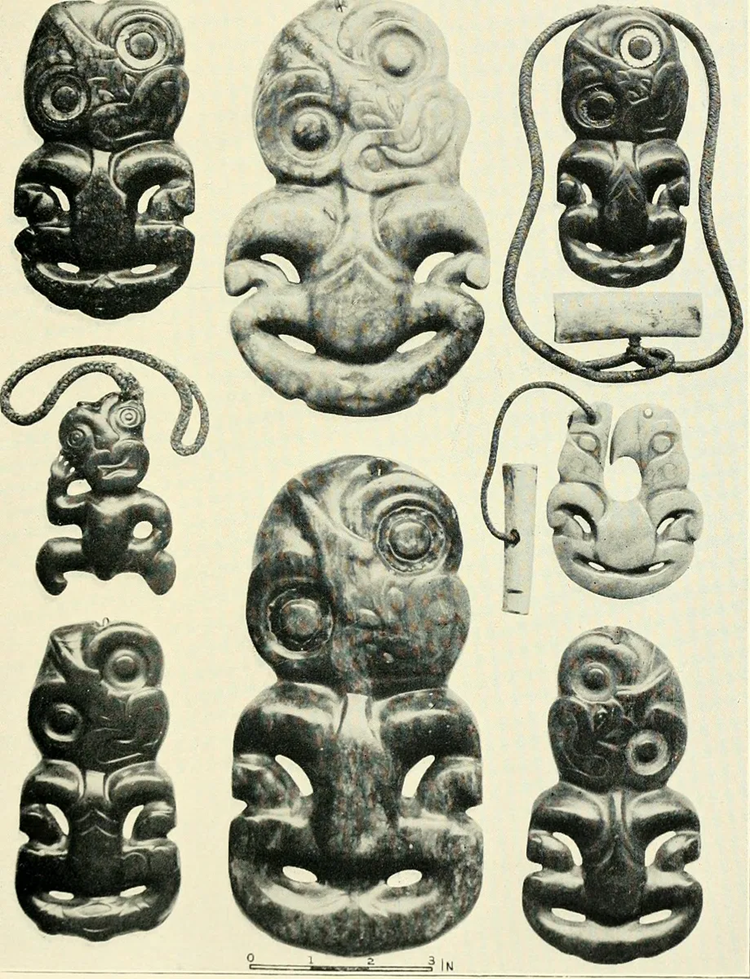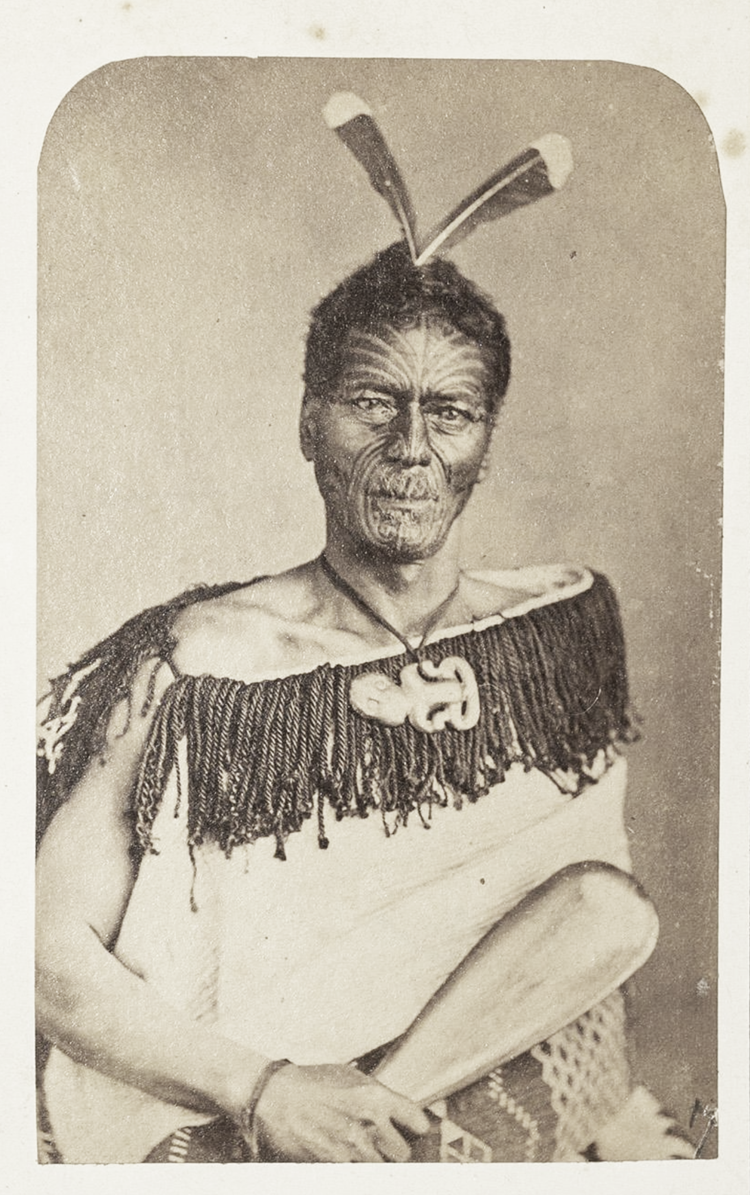Hei Tik Type 1
A superb, type I, Hei Tiki in the form of a stylized human figure with head turned towards the left shoulder. A bi-conical suspension hole is drilled through the top of the forehead along with the trace of a previous piercing probably in the form of an extended tab. The large oval head is detached from the shoulders showing the neck which is a rare typology. The face offers a powerful grimace with the nose carved with a double crossbar and the heart-shaped open mouth showing the canines and the curved, forked tongue (indicative of the power of political speech) over the pointed chin. The eyes are deeply set with large circular wells and prominent pupils under strong brows. The torso is finely rendered with the ribcage apparent, powerful shoulders, and the hands akimbo on the strong arched thighs. The three fingers of each hand are well detached from each other and the elbows, knees and ankles, and triple toes are indicated. The female gender is indicated by the presence of a well-defined vulva under the belly.
These nephrite (pounamu) Hei Tiki, hei (pendant) tiki (human image), were worn by men and women of high rank, and served both as ornaments and symbols of authority. They were imbued with sacred power (mana) and the material itself was reserved exclusively for owner ship by noble bloodlines. Hei tiki of this remarkable sculptural quality are rare, and this example is to be considered one of the very finest of its type.
Maori people, New Zealand, Polynesia. Nephrite with a fine patina of wear and age. Te Puawaitanga (the flowering) period (1500 – 1800 AD). 10,5 cm. 120 gr.
Provenance Private collection in Fells Point, Baltimore, Maryland, USA.
Literature:
Austin, D., Looking at Hei Tiki, Te Papa Blog, 15 Apr 2015. https://blog.tepapa.govt.nz/2015/04/15/looking-at-hei-tiki/
Austin, D., La Pierre Sacree des Maori, Musee du Quai Branly Jacques Chirac, 2017.
Dodd, E., The Ring of Fire: Polynesian Art, Dodd Mead & Co, 1967.
Kaeppler, A. L., Polynesia: The Mark and Carolyn Blackburn Collection of Polynesian Art, University of Hawaii Press, 2010.
Linton, R. & P. S. Wingert, Arts of the South Seas, The Museum of Modern Art, 1972.
Meyer, A. J. P., Oceanic Art, Könemann, 1995.
Starzecka, D. C., R. Neich & M. Pendergrast, The Maori Collections of the British Museum, British Museum Press, 2010.
The exceptional proportions, as well as the quality of the carving and the beauty of the stone, place the present hei tiki amongst the most remarkable treasures (taonga) of Maori art, an object, which superbly combines the principles of power and ornament and beauty.
The Hei Tiki – a cultural object worn around the neck - is considered a taonga tuku iho (treasured heirloom) because each hei tiki is handed down from one generation to the next and emotionally connect to the memory of tupuna (revered ancestors). No two hei tiki are alike and each one has its own personality imbued with wairua (spirit).
Most hei tiki, including many of the very large examples, are relatively narrow, having been carved from chiefly nephrite adze blades. Thus, the outer sides of the arms are flat edged and the general relation of width to length of the large tiki is quite low. Here we have a high ratio with a wide body relative to the length of the figure, which indicates that this Hei Tiki was carved from a particularly massive jade blade. It corresponds to the Type B of the Hei Tiki Shape Chart by D. Austin 2015. The body projects forcefully outwards. The tension of curve and counter-curve is accented by inclined planes drawing the eye inwards. The fine balance of the openwork areas of the arms and legs creates a perfect symmetry accentuated by the placing of both hands on the powerful thighs. The ribcage is well defined adding power to the large shoulders. The powerful face is symmetrically carved with strong brows framing wide set round eyes. The nose is flattened with large aggressive nostrils and the peaked bridge representing Mount Taranaki. The open, grimacing mouth offers a pointed lower lip, and two upper fangs protrude to either side of the extended, forked tongue.
Major General Horatio Gordon Robley, the great colonial period collector of Maori culture, noted in 1915, that there were two types of hei tiki. The first type is known as Robley Type A with the tiki head, turned left or right, resting on the shoulder, and with both hands positioned on the thighs. Type B is rarer with the tiki head raised, showing a defined neck, cut free of the shoulders, and with one hand raised to the chest or mouth and the other remaining on the thigh. Type B hei tiki also lack ribs, and one shoulder is hunched.
Most hei tiki are carved with the head inclining to the right and some to the left. There does not appear to be any particular significance to this, but those with the head to the left seem slightly more common. There is a small quantity of hei tiki carved with the head presented straight up in a natural position, this appears to be a more archaic format.
The material used for hei tiki is predominantly nephrite (commonly called jade). Other materials are Bowenite a softer serpentine stone, and possibly human bone – notable the skull – but this is not yet fully confirmed by research. The Maori recognize a wide range of colors in nephrite, each prized for a particular representation. The most coveted being the light « sea-green » or « milky green » nephrite (known as greenstone in New Zealand) which they call inanga or « whitebait » greenstone, because of its similarity to the colour of the whitebait fish (Galaxias maculatus).
Hei tiki were recorded by early European explorers such as Jean François Marie de Surville in 1769, and subsequently Captain James Cook and their followers. These famous ornaments, coveted by European visitors and collectors back home were a major source of income for Maori. Large numbers of Hei Tiki were produced in the European contact era. Most were manufactured in the late 19th century when the arrival of steel tools and industrial stone cutting equipment became commonplace.











